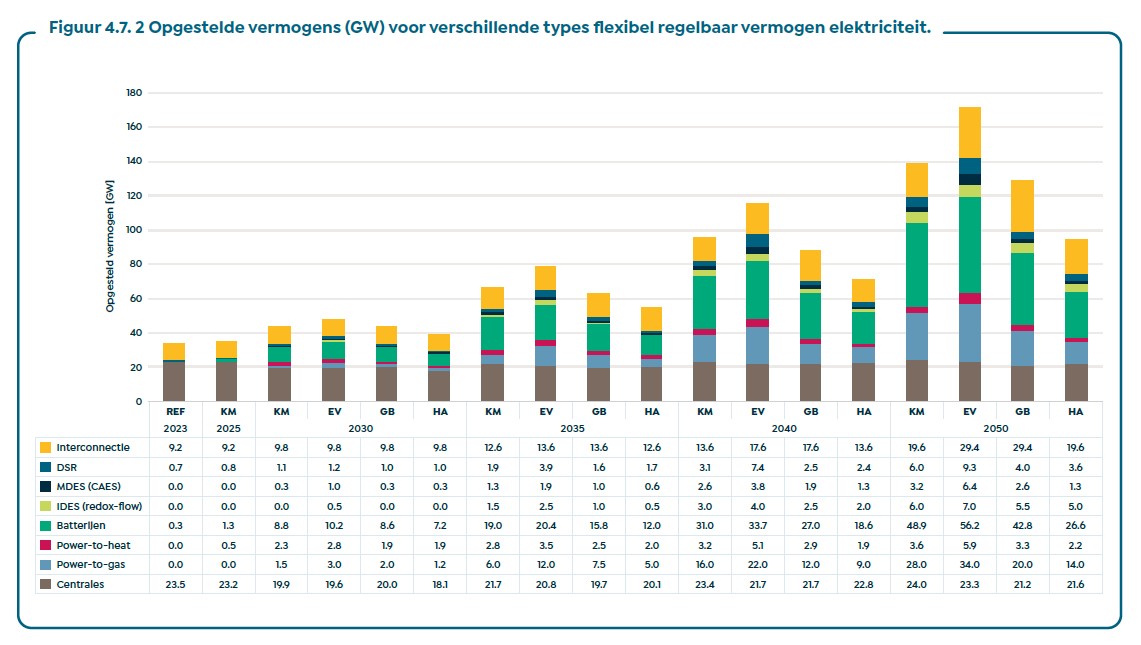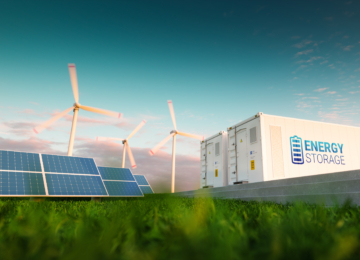Grid operators' scenario study: flexibility needs grow sharply toward 2050
In its Scenarios Edition 2025, Netbeheer Nederland has drawn up a future sketch of the energy system that must meet the Dutch climate targets by 2050. Whereas the Climate and Energy Outlook 2024 calculates what current policy will deliver, this report assumes that both national and decentralized policy will actually lead to goal realization. The result is a vision of the future in which energy generation, demand and flexibility - including storage - are in balance.
The report outlined four future scenarios, each based on different trends and policy directions. For example, the 'Steady Middle Way' scenario shows how the energy system will develop if current policies are continued, with a strong focus on electrification. 'Own Power' revolves around energy autonomy, with heavy deployment on solar, wind, hydrogen and heat networks, which puts a significant strain on the electricity infrastructure. 'Joint Balance' emphasizes European cooperation and the role of gas infrastructure, with the Netherlands playing a pivotal role as an energy transit country. In 'Horizon Supply', the energy system is heavily dependent on international imports of renewable energy and energy-intensive industry is partly relocated abroad.
Insufficient flexibility
A central conclusion of the report is that flexible power is becoming essential in an energy system that is largely electrified. The strong growth of weather-dependent solar and wind power is leading to large variations in supply. This requires a system that can dynamically move with and continuously balance with demand. Shortages, for example on cold winter days or during peak evening hours, must be better accommodated, while surpluses must be used efficiently. This requires investment and control. A wide range of flexibility options is needed, not only within the electricity system, but also in combination with other energy carriers such as hydrogen and heat.
The grid operators have deliberately included more flexibility in their scenarios than now seems realistic based on projects and market trends. The expected flexibility from the market lags behind what the energy system will soon need. This is why the network operators advocate further research into measures to ensure sufficient flexible capacity. Think of financial support for unprofitable flexibility options, improvement of market conditions or additional regulation.
In all scenarios, the installed flexible capacity increases significantly compared to the current situation. By mid-2025, this amounts to about 34 gigawatts, including power plants. In the 'Own Power' scenario, this could rise to as much as 170 gigawatts in 2050 - by far the scenario with the highest demand, due to the high degree of electrification as well as the large share of solar and wind.

Battery storage takes flight
Battery storage, meanwhile, is growing explosively. In 2021 it was still a few dozen megawatt hours of new capacity, by 2023 it will be hundreds of MWh and now thousands of MWh are in the pipeline. This growth reflects the need for short-cycle flexibility to accommodate erratic solar and wind generation and smooth out grid peaks. For the longer term, the report calculates a battery capacity of 0.05 percent of annual electricity consumption, amounting to some 26 GW in the "Courseable Midway" scenario and 56 GW in "Own Power. A distinction was made between standalone storage, co-location with solar or wind farms, behind-the-meter systems for households and vehicle-to-grid (V2G) applications in charging infrastructures.
Total large-scale storage capacity grows to about 25 to 27 GW by 2050. Batteries at wind farms increase from 0.2 GW in 2025 to 1.5 GW in 2050. Solar farms then contribute 7.6 to 10.9 GW, while households can provide 8.4 to 14.5 GW of behind-the-meter storage. V2G applications range from 4.5 to 9.5 GW. Storage duration varies by application: from 2 to 8 hours for large-scale and colocation storage, to 4 to 8 hours for V2G. That diversity enables the provision of different services, such as control power, peak smoothing and emergency reserve.
Heat storage as a link in heat grids
Heat storage will also have a key role in the natural gas-free energy system of the future. Heat buffers will become crucial in low-, medium- and high-temperature grids. Although the report does not provide a technology breakdown, generic storage volumes have been calculated through the Energy Transition Model. In medium-temperature grids, the storage volume increases from 1.1 TWh in the 'Courseable Middle Way' scenario to 3.9 TWh in 'Own Power'. In high-temperature grids, this ranges from 0.3 to 2.6 TWh. This storage is needed to store summer surpluses of solar or waste heat for use on cold days. In low-temperature grids, seasonal storage remains limited, as these grids have mainly direct supply. Large-scale rollout of seasonal storage is not expected until 2030.
Short-cycle heat storage, such as daily and weekly storage with technologies like TTES and PTES, can help accommodate peak production. But large-scale deployment still faces financial, legal and societal obstacles - a focus for policy and market development.
Storage of molecular energy carriers (methane and hydrogen)
Finally, molecular energy carriers, such as methane and hydrogen, are also important as sources of flexibility. These act both as seasonal buffers and to smooth out short-cycle variations. For methane, gas storages remain the cornerstone of storage. As demand for natural gas declines, the required storage volume drops from 33.1 TWh in 2025 to 20 TWh in 2050 in the "Heading Midway" scenario, and even to 4.5 TWh in "Equity. Hydrogen storage is smaller in size, but important for short-cycle flexibility. In 2050, storage capacity is 0.25 TWh in 'Heading Middle Way' and 'Joint Balance', and 1.25 TWh in 'Horizon Supply'. Storage takes place in caverns and gas fields, with limited space for new salt caverns meaning that existing gas fields continue to play a major role.






